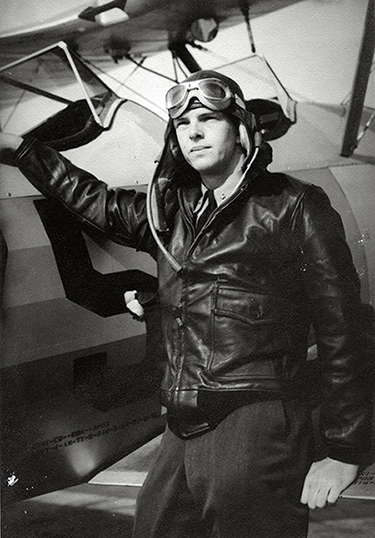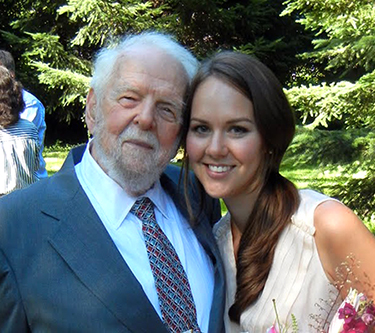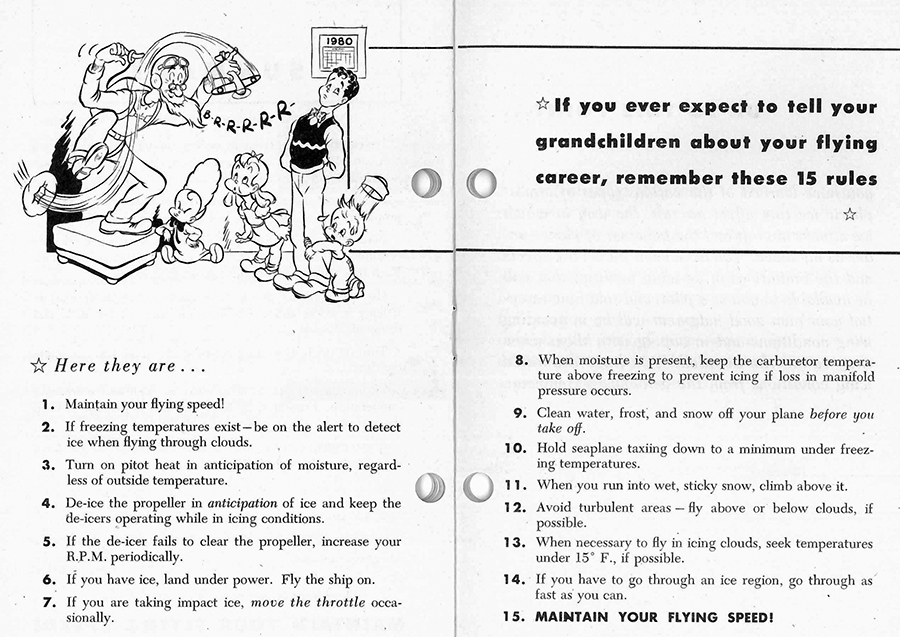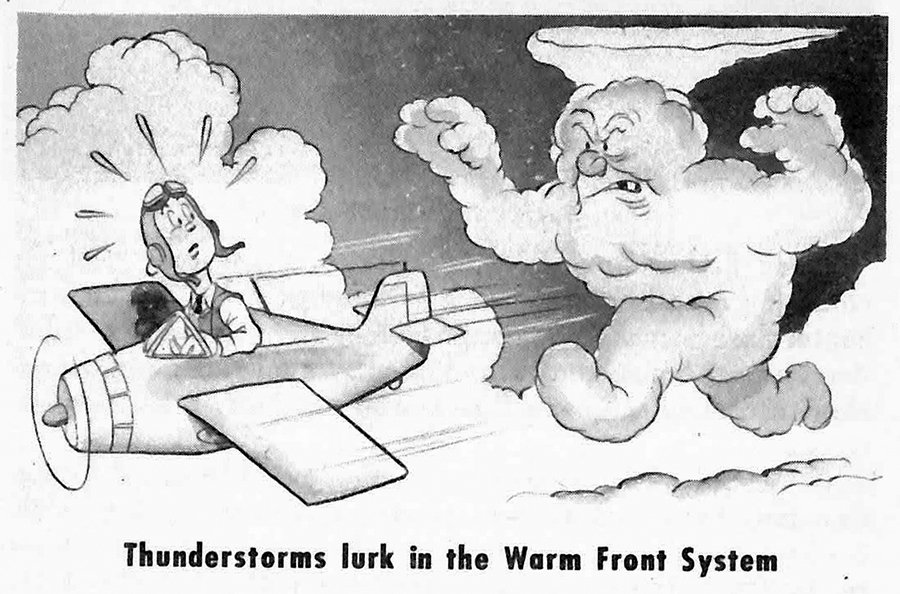Navy pilot training manuals from the ’40s stand test of time
When Prof. Elizabeth Barnes received eight Navy pilot training manuals that belonged to her grandfather, she knew she had an interesting artifact worth sharing.
“I really like them. [They’re a] great example of taking complex scientific information and boiling it down to its most practical to get a pilot from A to B and home again. Plus, the cartoons are incredibly entertaining.”
Right she was. Everyone in the department who glimpsed the manuals on a desk in the main office was curious about them, and cartoons like these drew them in:

The 4.5 x 6.5-inch booklets are from the Navy’s Aerology Series, “prepared for Naval Aviation Cadets by the Bureau of Aeronautics Training Division” and published in the 1940s.

William Franklin Barnes when he was a cadet at age 18 or 19.
Their historic perspective is evident from the opening sentences of the first book in the series, Ice Formation on Aircraft:
“You have two enemies more deadly than a Zero [Japanese fighter aircraft] or a Messerchmitt [German fighter aircraft]. They are… CLEAR ICE and RIME ICE. Yet these enemies are sportsman-like enough to give you warning.”
The series explains weather conditions and how to fly safely in each type of condition or how to avoid it. Because the manuals pertain to meteorology, Barnes’ aunt, Lesa Barnes, thought Barnes would find them interesting and mailed them to her. Lesa came across the books while going through her father’s belongings to prepare for a move. Barnes’ grandfather, William Franklin Barnes, is doing well at 93 and lives near Seattle. He was a Navy pilot for 23 years, from 1942 to 1965, and flew during a wartime campaign in Korea from the summer of 1950 to spring 1951. Following his time in the service, he taught middle school math.
“He’s still sharp,” Barnes said. “As an example, he is part of a group of retirees that gets together and discusses the latest problems in astrophysics. They read the journal Scientific American and then get together and discuss/argue about the contents. This would lead to lots of questions for me about the universe expansion and what I thought about string theory – not like I had many answers for him.”
Barnes’ grandfather said he was able to put the information in the books to good use.
“I must have. I know I did. I used the information, as modified, throughout my flying career. When I was a cadet I was given a set of booklets in Ground School in 1942, in Cottonwood, Arizona. When finished with Ground School, I obtained a new set and it is this new set, unread, that I saved.”
The books illustrate how vital understanding weather and the atmosphere are to a pilot and to the overall cause, referencing specific battles that were successful because of advantageous weather.
“Many a Navy attack has been timed to conform to weather favorable to the tactical situation. The raid on the Gilbert and Marshall Islands, for example, was so planned that our aircraft left their carriers, made their raid, and returned to their bases under favorable flying conditions, after which the ships took cover in a frontal area that protected them from aerial reprisals all the way out of the combat zone.”

Elizabeth Barnes and her grandfather, William Franklin Barnes, 2011
Our understanding of weather conditions and how and why they occur has advanced considerably since the ’40s, thanks in part to the research conducted by CSU’s Department of Atmospheric Science, including Barnes. According to Barnes, the information in the manuals has held up against the test of time. The basic weather information is still accurate, and it was sufficient for its intended purpose.
“From the parts I have read, certainly looks like it. At the end of the day, these manuals are mostly there to tell the pilots ‘the way things are,’ rather than ‘why they are the way they are’. A lot of progress has been made since the 1940s on understanding atmospheric flows, however, these details probably weren’t pertinent for the intended audience and application (i.e. pilots in the Navy).
“At this time they didn’t really understand the storm tracks or jet streams – which is actually what I study! They knew that storms tended to follow certain paths over the oceans, but the concept of the ‘jet stream’ was only just starting to be realized. Instead, everything was thought of in terms of ‘fronts’. A cold front, a warm front, an occluded front.”
Not only are the books full of practical and potentially life-saving knowledge, the many illustrations use humor to bring levity to serious subject matter. Barnes found several of them particularly applicable and amusing.
“These two are favorites, as it is how I feel trying to read a weather map/forecast.”

“Another favorite – since obviously, I AM his granddaughter!”

Because Barnes’ grandfather did so many things after his days as a pilot in the Navy, he had to be prompted to share stories from that time in his life.
“Typically, we would have to ask him for stories if we wanted them, although he would be constantly building model planes of the aircraft he had flown (so he would actively discuss those). One interesting tidbit is that he was part of the first team to land on aircraft carriers at night – which was quite different than landing during the day when you could see what you were doing!
“He also has a story about flying through the Grand Canyon (back when that was allowed) and getting stuck in a downdraft right when he needed to pull up, and how the plane lifted at just the last second before the canyon ended. He said he never told my grandmother about that day.”
The eight Aerology Series manuals are currently on display in the ATS Main entryway.



